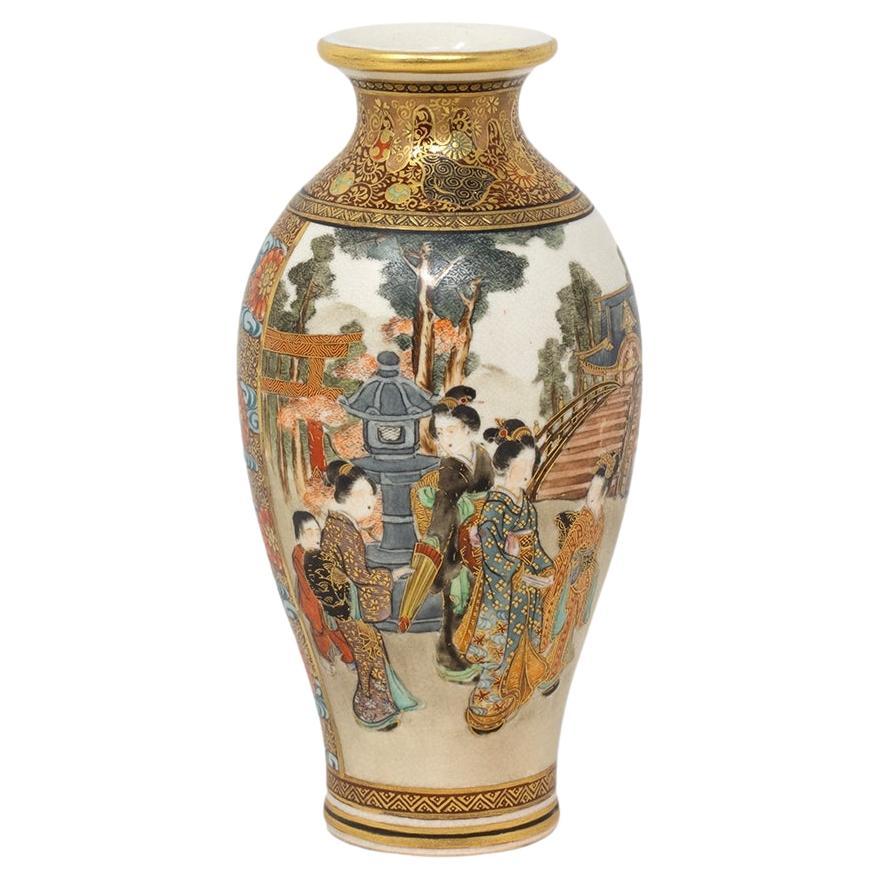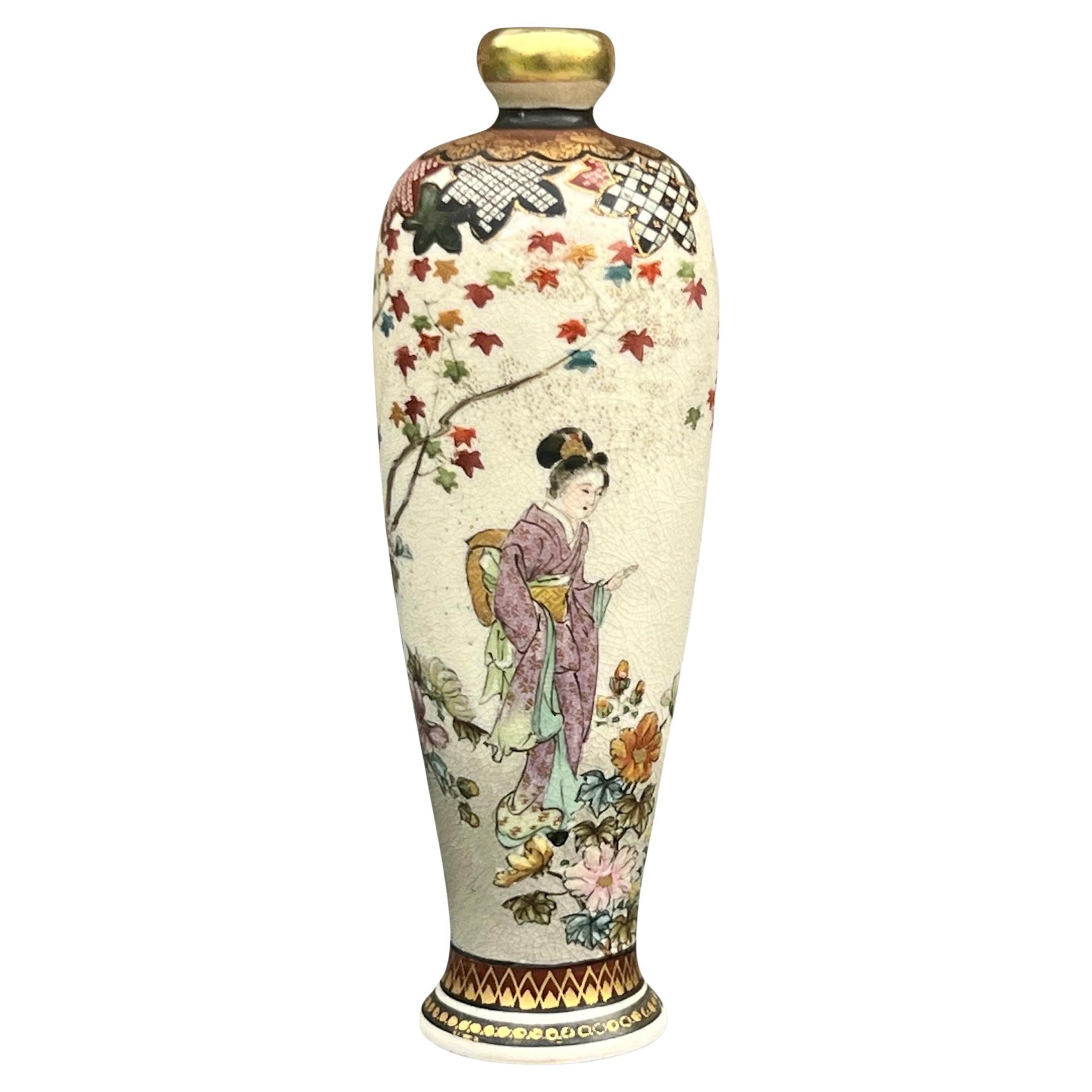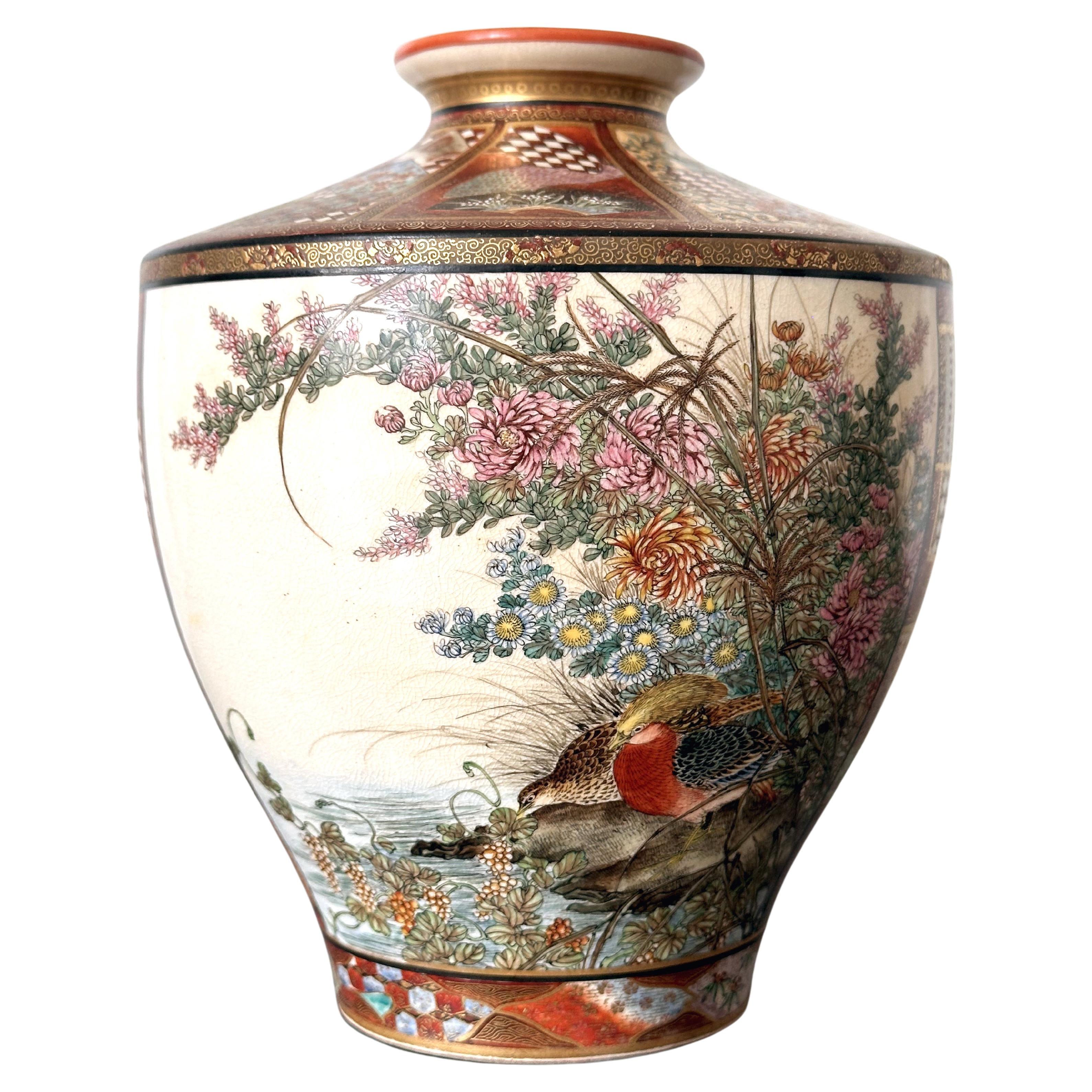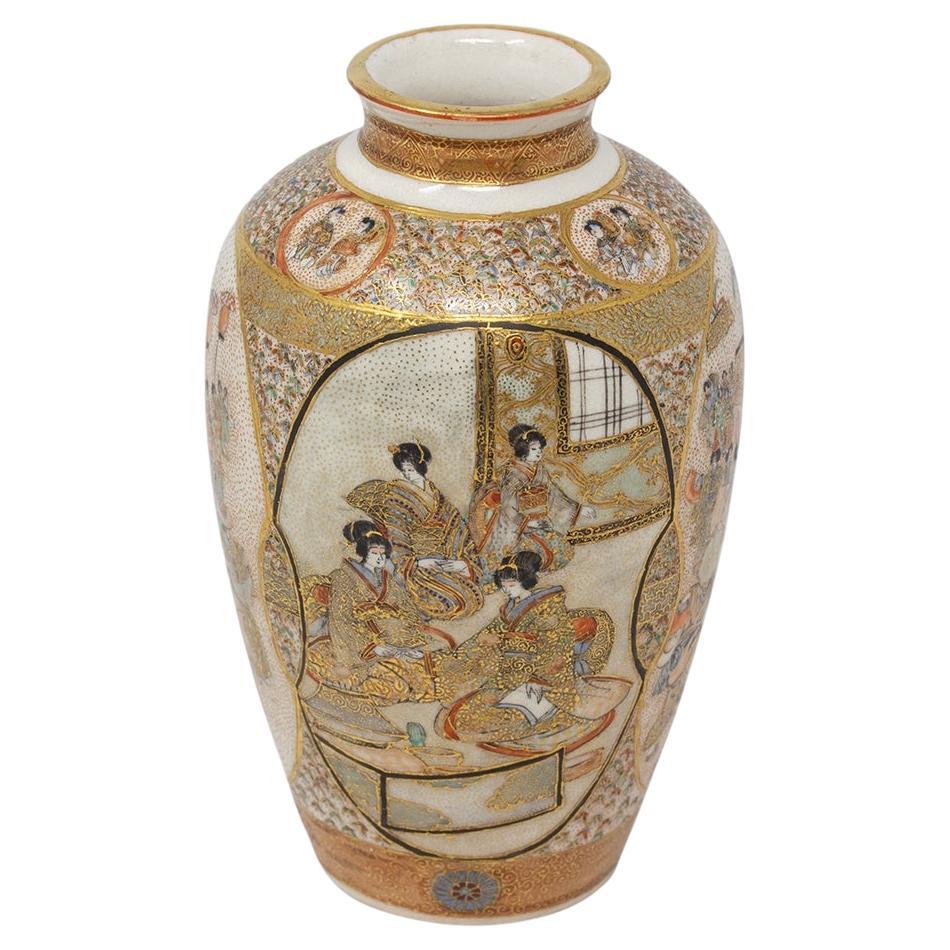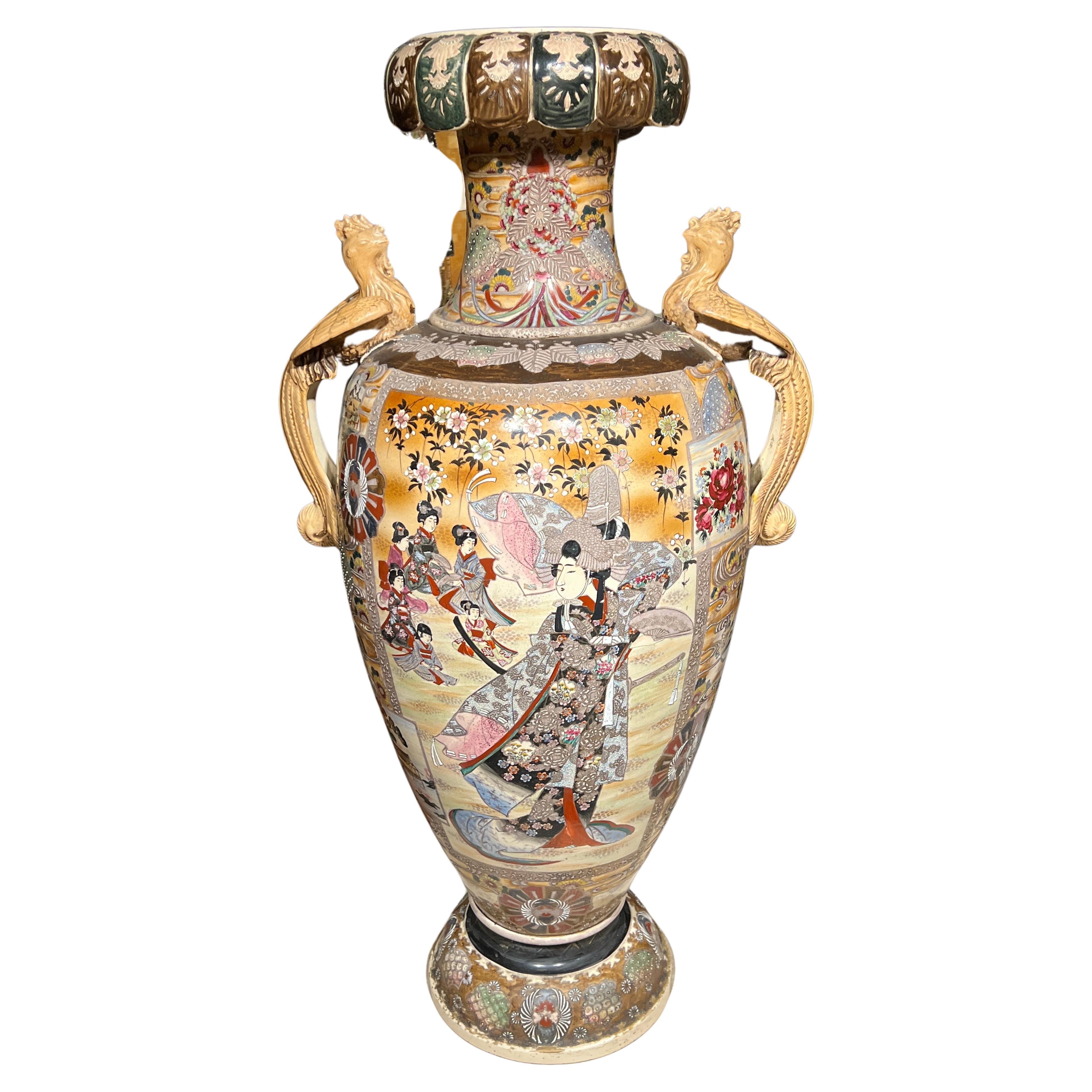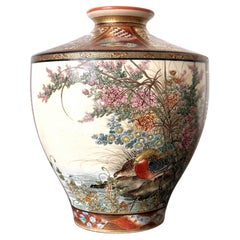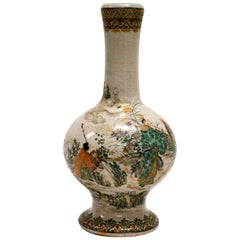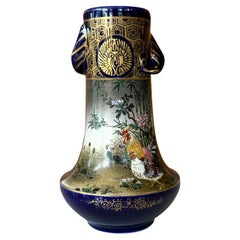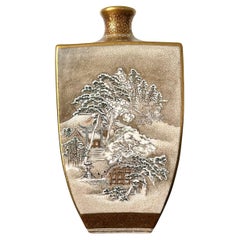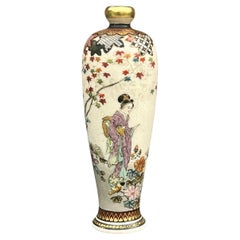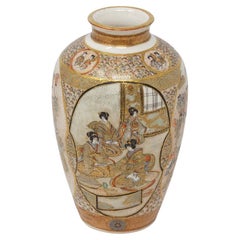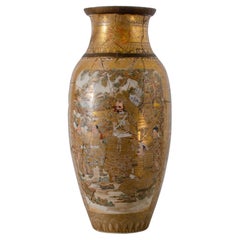Items Similar to Exquisite Japanese Satsuma Vase by Seikozan
Want more images or videos?
Request additional images or videos from the seller
1 of 18
Exquisite Japanese Satsuma Vase by Seikozan
$9,500
£7,280.60
€8,367.77
CA$13,343.22
A$14,933.52
CHF 7,817.17
MX$181,415.21
NOK 99,258.13
SEK 93,667
DKK 62,438.29
About the Item
A miniature vase in elegant upright form reminiscent of the Chinese imperial Willow Leaf form made by Japanese studio Seikozan circa 1890-1910s (late Meiji Period). One of the many artist studios that specialized in satsuma ware, Seikozan was perhaps a handful exceptional establishment in Kobe that produced the pieces with the highest quality and best craftmanship, on a similar level of Yabu Meizan. The output was small and most limited to miniature scale with impeccably detailed surface decoration.
This vase is a showcase in artistry of the finest caliber. The entire surface was painstakingly decorated with seven shaped vignettes, including an incense burner, a teapot, a fan, a covered jar, a long neck vase, a cup and a round dish. snapshots of daily life with participating characters and landscape were filled artistically with astonishing attention to details. The vignettes are arranged to link with each other and to circumvent the entire surface of the vase. It can take one a long time to observe and appreciate all the stories unfold in the small space. The geometrical background is a lattice of diamond shapes. Numerous bands of contrasting designs circle the top and the bottom of the vase. The dense design is a common feature of satsuma wares; however, the overall harmonious composition and impassible workmanship elevate this piece to the peak of this art form. Signed "Seikozan" on the bottom.
For more information on Seikozan and other similar works, refer to "Satsuma Masterpieces from the world's important collection" and "Satsuma the Romance of Japan" by Louis Lawrence.
- Dimensions:Height: 6.25 in (15.88 cm)Diameter: 2.25 in (5.72 cm)
- Style:Meiji (Of the Period)
- Materials and Techniques:
- Place of Origin:
- Period:
- Date of Manufacture:1890s-1910s
- Condition:Wear consistent with age and use. Fine condition. Inner rim micro uneven. Contact wear on the base with an old sticker residue.
- Seller Location:Atlanta, GA
- Reference Number:1stDibs: LU945025415932
About the Seller
4.9
Platinum Seller
Premium sellers with a 4.7+ rating and 24-hour response times
Established in 2006
1stDibs seller since 2010
565 sales on 1stDibs
Typical response time: <1 hour
- ShippingRetrieving quote...Shipping from: Atlanta, GA
- Return Policy
Authenticity Guarantee
In the unlikely event there’s an issue with an item’s authenticity, contact us within 1 year for a full refund. DetailsMoney-Back Guarantee
If your item is not as described, is damaged in transit, or does not arrive, contact us within 7 days for a full refund. Details24-Hour Cancellation
You have a 24-hour grace period in which to reconsider your purchase, with no questions asked.Vetted Professional Sellers
Our world-class sellers must adhere to strict standards for service and quality, maintaining the integrity of our listings.Price-Match Guarantee
If you find that a seller listed the same item for a lower price elsewhere, we’ll match it.Trusted Global Delivery
Our best-in-class carrier network provides specialized shipping options worldwide, including custom delivery.More From This Seller
View AllFine Japanese Satsuma Vase by Ryozan Okamoto for Yasuda Company Meiji Period
Located in Atlanta, GA
A finely decorated Japanese satsuma ceramic vase by Ryozan Okamoto (c.1820s-1910s) for Yasuda. Ryozan is the head artist working for Yasuda company, a Japanese ceramic makers and dea...
Category
Antique Early 1900s Japanese Meiji Ceramics
Materials
Ceramic
Early Japanese Satsuma Antique Vase
By Satsuma
Located in Atlanta, GA
An Satsuma ceramic stone ware vase, circa 19th century, around the end of the Edo and the beginning of Meiji period. In the form of a Classic garlic bottle whose prototype was from China, the white bodied piece is decorated with an early form of kin nishikide, the so called golden brocade, a palette of iron-red, blue, green, yellow, purple and black with golden highlight. The over glazed enamel paint shows a group of robed figures in a garden setting with a lion and three tigers. A transparent overall glaze shows very fine crackles. The design is relatively sparse with plenty of negative space in contrast to the Satsuma production from the late 19th century, when the trend became fussy and overly glitz, due to the influence by the perceived western taste for the export market. This piece may still be made for export but its pattern was more influenced by both Kyoto Pottery and the Kano school of painting compared to the export ware by the end of the 19th century onward to the early 20th century. It was believed by many that this was a result of Satsuma potters visiting Kyoto in the late seventeenth century to learn over glaze painting techniques.
There are some age glaze crackles especially around the foot. The piece is not signed in keeping with the earlier production before Satsuma ceramics...
Category
Antique Mid-19th Century Japanese Japonisme Ceramics
Materials
Ceramic
$2,850 Sale Price
25% Off
Fine Japanese Ceramic Satsuma Vase by Kinkozan
By Kinkozan
Located in Atlanta, GA
A miniature Japanese ceramic vase from the end of Meiji period circa 1880s- 1910s by Kinkozan (1645-1927). One of the largest studio manufacturers of the export ceramics at the time ...
Category
Early 20th Century Japanese Meiji Ceramics
Materials
Ceramic
Fine Japanese Satsuma Vase with Superb Decoration by Seikozan
Located in Atlanta, GA
A ceramic vase in tapered square form made by Japanese studio Seikozan circa 1890-1910s (late Meiji Period). One of the many artist studios that specialized in satsuma ware, Seikozan...
Category
Antique 1880s Japanese Meiji Ceramics
Materials
Ceramic
Large Japanese Satsuma Ceramic Vase Kinkozan
By Kinkozan
Located in Atlanta, GA
A large Japanese ceramic vase from the end of Meiji period circa 1890-1910s by Kinkozan (1645-1927). One of the largest studio manufacturers of the export ceramics at the time based in Kyoto. In the typical style of satsuma made at the turn of 20th century, the vase is elaborately decorated with a rather unusual kinran-de (gold paint) and green enamel highlight on a mottled brown background. The painterly decoration depicts a large seasonal floral arrangement in a circular fashion. Besides the obviously superb craftsmanship, what sets this particular vase apart from many lower quality and mass-produced pieces is its tone-on-tone color pallet that is visually somber and the small and sensitive details that heralds the change of the seasons. When the viewer goes beyond the first casual glimpse of the blossom and foliage, one would notice that on the edges of certain leaves as well as along the stalks, there accumulates a very thin layer of the white dust that represents the frost. The flower in bloom are chrysanthemums. Despite of being splendid, they are the messengers of the autumn. The large lotus leaf was subtly rendered in a bended and slightly withered manner, just past its prime. Although the lotus is still in bloom, the prominent seed pod indicates it may be the last for the season. The sentimental capture of the change of the seasons is not unusual in Japanese art. This vase poetically represents such a subtle transition from summer to fall, perhaps depicting the very first frost.
The neck of the vase is also slightly unusual with two rolled rings...
Category
Early 20th Century Japanese Meiji Ceramics
Materials
Ceramic
Japanese Miniature Satsuma Vase Yabu Meizan Meiji
By Yabu Meizan
Located in Atlanta, GA
A small Satsuma vase from the studio of Yabu Meizan (birth name Yabu Masashichi; 1853-1934), who is one of the most celebrated and collectible Satsu...
Category
Antique Early 1900s Japanese Meiji Ceramics
Materials
Ceramic
You May Also Like
Japanese Meiji Period Satsuma Vase by Ryokuzan
Located in Newark, England
From our Japanese Satsuma Collection, we are delighted to offer this Japanese Satsuma Vase by Ryokuzan 緑山. The Satsuma vase of ovoid shape with a tapered body, circular foot rim, wai...
Category
Antique Early 1900s Japanese Meiji Ceramics
Materials
Ceramic, Earthenware, Pottery
A Fine Japanese Satsuma vase signed by Ryokuzan. Meiji period
Located in London, GB
A exquisite Satsuma vase signed by Ryokuzan.
Meiji Era.
Of a slender ovoid shape featuring intricate hand-painted designs and delicate gilded accents.
The vase is adorned with...
Category
Antique 19th Century Japanese Ceramics
Materials
Ceramic, Porcelain
Antique Japanese Meiji Period Satsuma Vase by Ryozan
Located in Newark, England
MEIJI PERIOD 1868-1912
From our Japanese collection, we are delighted to offer this Japanese Satsuma Vase by Ryozan. The vase of tapered form with tightly pinched neck and flared to...
Category
Antique Late 19th Century Japanese Meiji Ceramics
Materials
Ceramic, Earthenware, Pottery
Large Repaired Satsuma Vase, Meiji
Located in Savannah, GA
A large Meiji period Satsuma vase, late 19th century.
Fully shattered and repaired.
11 ½ inches wide by 24 ½ inches tall
Category
Antique Late 19th Century Japanese Meiji Ceramics
Materials
Ceramic
Very Fine quality Monumental meiji period Japanese Satsuma Vase
Located in New York, NY
A very fine quality monumental Japanese vase depicting Samurai on one side and distinguished female and her attendants on reverse, particularly unique for its very prominent stylized...
Category
Antique Late 19th Century Japanese Ceramics
Materials
Porcelain
Antique 19th Century Japanese Satsuma Vase Richly Decorated Marked Base Japan
Located in Amsterdam, Noord Holland
Lovely etailed piece. Marked on base with makers mark and mon crest
Condition
Overall condition perfect. Size: 294mm
Period
Meiji Periode (1867-1912).
Category
Antique 19th Century Japanese Meiji Ceramics
Materials
Earthenware
$850 Sale Price
20% Off
More Ways To Browse
Exquisite Antique
Japanese Fans
Japanese Fan Art
Long Neck Vase
Japanese Satsuma Vases
Antique Satsuma Vase
Miniatures Japan
Antique Miniature Vases
Antique Japanese Fans
Antique Japanese Cup
Teapot Japan
Lattice Vase
Antique Japanese Miniature
Antique Fan Vases
Japanese Ceramic Cups
Japanese Incense Burner Antique
Antique Japanese Teapots
Japanese Lattice
